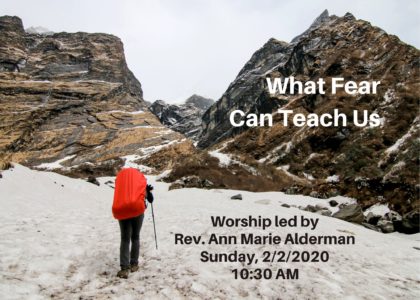This morning I will be talking about fear and its useful purpose. Because I sometimes fear being accused of plagiarism, let me say for the purpose of full disclosure that I borrowed the title of this sermon from a TED Talk by novelist Karen Thompson Walker.
She says in her TED Talk that our fears have something important to teach us, as long we understand what we need to pay attention to.
How many of you remember stories you were told as a child about fears that were conquered? How many of you, when you got older, heard the message that you should just put your fears aside, just move forward, ignore the monsters? Heard something like believing in monsters is childish and you are no longer a child?
Given the circumstance of this week, ignoring the monsters may be getting harder and harder to do.
Perhaps we ought to have learned that we can’t and shouldn’t ignore fear. We can’t pretend we don’t feel it. What we can do is understand that fear in and of itself is not a danger. Fear is a feeling, and it is an important feeling.
What are you feeling fearful about? That your parent isn’t going to make it all right? Are you afraid that you are going to run out of time to do what you want to do? That no one is going to show up and take your place and everything you have built up will fall without you? Are you fearful that history will repeat itself? That the future will be not just hard, but deadly for you, for your family, for many; for the places, the people, the animals you care about?
All these frightening possibilities and more are part of our story as human beings. They are fears serving the purpose of teaching us something important.
Karen Thompson Walker says that the stories we tell ourselves when we are afraid ought to be honored as amazing creations of the human imagination. All stories hold meaning, especially those based on our fears. Ignoring them means we miss the very thing we ought to pay attention to!
We may think we are all grown up when we can see that there really are no monsters that exist in the same way in our waking lives as they do in our imaginations. Yet I can assure you that the most creative thinkers don’t even try to leave their fears behind. They know that it is the stories that are based on our worst fears that can and will teach us what we need to know in order to survive.
It is the fear you choose to listen to that governs whether you live or die.
I went on a three-day backpacking trip with a bunch of Eagle Scouts some years ago. Why? Because the troop leader was a friend. He had—for several years—told me about the backpacking trips he had taken or was about to take on the Appalachian Trail, and every time I had responded, “I have always wanted to do that.” So, one spring he called me and said he didn’t have enough adults to chaperone, and didn’t I want to go?
I surprised myself by saying yes. I borrowed equipment. I showed up at 40ish to go hiking with 12 high school boys and my friend, who was a firefighter and an EMT at his real job. He had invited another friend of his, also an older, out-of-shape backpacker wannabe.
On both mornings of the hiking part of our adventure, we started off all together. And within 15 minutes, the other friend and I were together alone with 7.5 miles to go. The first day the trail was relatively flat and beautiful with lots of little streams to cross. The two of us weren’t enamored with each other and soon separated. It was beautiful and I loved the solitude of the not-really-chaperoning-anyone hike. Then it rained the entire rest of the day, so everything I had on got soaked.
The next day, my friend told me that I would, by mid-hike, have a choice to make. I could take the easier, longer way around Albert Mountain, or (and he would not recommend it) I could go up and over. Looking at my waterlogged leather boots, he figured I would certainly have my wits about me by mid-hike and make the right decision.
Most of the first part of that day, for three hours or so, I was alone on the many switchbacks, working my way up to the fateful bottom of the warned-about steep Albert Mountain ascent. Just before I arrived at where I had to decide to go around or up, a couple breezed past me. I was already exhausted—my boots so heavy—but they, a younger woman and an older man, strolled past me like they were on a path in a neighborhood park. They headed straight up the mountain. I did too.
I never saw them again.
I soon found myself struggling up the difficult series of winding steps, some stone, but most old and now-rotten logs, all covered in slick mud. My pack weighed 28 pounds. It felt like 100. Every step up was difficult and scary. Every single step involved thinking about where my foot was going to land, but not only with that step. I not only had to consider my next step, but the ones afterwards as well. I found out all too quickly that backing down and repeating my steps, because I couldn’t do the third or the fourth step in the path I had been headed up, meant my load would shift too much to the right or the left. Stepping back down to start again would mean the balance I was being so careful to maintain would shift in a way that meant I risked falling.
I was feeling the fear! My biggest one was that I had made a stupid choice and would be found out—as stupid.
My fear became a story with a character who had made the wrong decision, had not listened to good advice and who fell to her untimely death. Or she slipped, then fell, and was alive, but the rescue helicopter had no place to land. Or she fell, and at nearly nightfall the 12 young male scouts found her and carried her to camp. And they were then forever scarred by the mental images of what strong women really looked like: stupid and not capable of hiking of a medium grade mountain.
The suspense made the story I had created in my head. Could the chaperone manage herself well enough to survive?
Your fears always create scenarios full of suspense. What will happen next?
Our fears create characters and plots with beginnings, middles and ends. All the fear stories contain the key middle ingredient, the suspense, the what happens next? just like in any good story. If this, then that. If that, then this… and on and on we go.
Karen Thompson Walker says we ought to think of ourselves as the authors and as the readers of our fear stories. Some creative people call the process of paying attention to their fears and the different ways things may play out productive paranoia!
Why productive? Because being fully aware of your fears means you have a chance to put a plan in place for the very worst thing that could happen. And if you have a plan for the worst that could happen, it likely won’t.
Our worst fears may not predict what will really happen. But our fears, even our worst fears, are useful. They are useful in helping us face the possible future, and make a plan for that.
It is important to know which fear to pay the most attention to.
We can learn not to be taken in by the most vivid, the goriest, the bloodiest, the most horrible of our fears, the biggest monsters; but rather to consider the most likely what if. Karen Thompson Walker says it is a matter of balancing with science or data the kind of creative passion that makes for a good story. In other words, considering what is the most likely outcome if we think of the if this, then that.
I think the point she makes is to listen to your fears, all of them; then consider not only what is the most vivid, but which fear is creating a story about the most likely future; the one in which we still survive, even thrive.
I did put one foot in front of the other, over and over. I did slip a few times, but not to my death. I did have to back up a few steps and start over again and again. And I was afraid. But I was focused, always focused on the next three steps. Over and over and over, the next three steps.
I remember stopping in the middle of that scary part of the day’s hike and telling myself that what I was doing was a metaphor for what I would need to do in life. Not panic, not give in to my biggest fear (which was of being stupid), but keep putting one step in front of the other. To not let my sense of shame create my story.
When I reached the top of dear Albert Mountain, I thanked him for the life lesson.
Perhaps there is a lesson to learn in paying attention when someone way more experienced tries to steer our choices. For me there was and is a bigger lesson to hear: Don’t let my sense of shame make me give up the journey forward. I faced my monster and chose a different if this, then that.
When I got to the top, the wind shifted and the fog was so thick, I didn’t even stop as there was nothing to see, and I started down. My sore feet felt every pebble in the very rocky, dry path that I hoped kept descending into our camp for the night.
It wasn’t long until I saw my friend coming toward me and gladly gave him my pack when he offered to carry it. He was worried about what was taking me so long, so he had asked the young woman/older man couple when they arrived in camp if they had seen me. “Oh, yeah, right behind us for a minute or two, heading up Albert Mountain,” they had answered.
Fears can teach us what we may need to know to survive, if we pay attention to all that our imagination creates and pick the one that isn’t the worst one, but the one we can move through with a plan to survive, even to thrive.
Let us keep to the journey, determined to step forward with faith and with confidence.
If you appreciated this sermon, please text to give or visit our Give Now page to support the UUCSH Share the Plate efforts to assist those in need.

